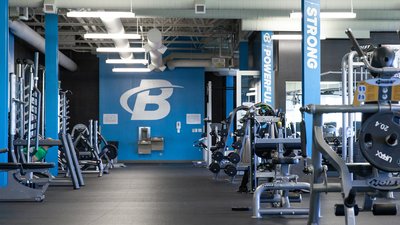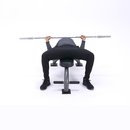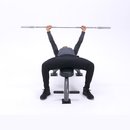Basic strongman training is not a mystery to anyone familiar with the sport. You simply train for the actual events by performing them in the training hall. In the gym most amateur strongmen are performing the standard power exercises: the deadlift, the bench press, the squat, and the shoulder press. That's great, but if you expect to compete at the international or even national level you will have to do a lot more than that.
Read on and I will teach you one of the most advanced weight training techniques in the world for developing tremendous muscle size and strength. Little used in the West, this technique has been a staple of Eastern European strength athletes for decades.
A Look At The Science
Let me start with a basic science lesson. The stimulus for muscle growth is stress; i.e. weight lifting. However, muscle growth is not a major priority for the adult human body. Generating new muscle tissue requires a large diversion of the body's limited energy and resources.
The human body is a very efficient biological machine that has only one major goal - survival. Your body is constantly trying to conserve energy so that it can complete the thousands of tasks necessary to sustain life: breathing, blood circulation, fighting infection, etc. It is also continuously trying to maintain a constant and efficient state of equilibrium (the correct medical term is homeostasis).
Your body quickly responds to any disruptions in its equilibrium by taking defensive actions. For example, when you have an infection, your body increases the production of white blood cells in order to combat the infection. When you lift heavy weights, you are disrupting the body's equilibrium.
Lifting weights that are heavier than your muscles' normal maximum lifting capacity causes your body to divert large amounts of energy and resources to those muscles in order to assist them. If your muscles were larger, then they could handle the heavy weights without requiring the extra resources.
When your muscles are consistently over-stressed, your body takes the defensive action of building larger muscle tissue. In actuality this process is far more complex. But, we as strength athletes only need to understand the basic principles of muscle growth in order to manipulate our bodies into growing larger and stronger muscles.
The bottom line is this: maximum muscle overload equals maximum muscle growth. In fact, muscle overload is the only stimulus for muscle growth. In the gym this simply means lifting extremely heavy weights. But any experienced lifter knows that this is easier said than done.
Lifting extremely heavy weights often results in extremely serious injuries. So what is the solution? Lift extremely heavy weights only in the strongest and safest part of the movement.
By eliminating the weak and risky section of the movement, you drastically decrease the risk of injury yet lose absolutely no growth potential. In fact, you will greatly increase the growth potential of your muscles because now that you are doing safe, strong range repetitions, you can handle much heavier weights than normal.
In many cases you will be able to lift double what you would normally lift for a full range repetition. Remember, when you eliminate the weakest link, the chain becomes stronger even though it is now shorter.
Dispelling A Myth
It is a myth that in order to achieve full muscle development, you must use a full-range repetition. There has never been a scientific study demonstrating that a full-range motion is required to stimulate muscle growth. Remember, maximum overload is what stimulates muscle growth; flexibility plays absolutely no part in the process. If it did, yoga practitioners would be the most muscular people on earth.
Incorporating heavy partial-range repetitions into your normal training regime will not cause you to lose flexibility or full-range functional strength and, unlike traditional weight training techniques, heavy partials are actually good for your joints. Why?
As your muscles grow in response to the tremendous stress placed upon them, ligaments, tendons, and bones become thicker, denser and stronger in order to support the larger muscle mass.
The goal here is to turn you into a bigger, and therefore stronger and faster, strength athlete. Obviously if you are bigger, stronger and faster your performance in the strongman events will improve dramatically.
Down To Business
OK, let's get down to business. We will be using the four basic power exercises mentioned earlier: the bench press, the squat, the deadlift, and the shoulder press. Be sure to use an amount of weight that will cause you to reach absolute exhaustion after 5 or 6 reps on your first set. This is extremely important.
Of course a little experimentation will be required the first time that you try heavy partials. If you reach complete exhaustion after only 1 or 2 reps on your first set, then the weight is too heavy. If, on the other hand, you are able to perform 9 or 10 reps, then the weight is too light.
Why are 5 or 6 reps best? The answer is: muscle overload and energy output.
Using a weight that is so heavy that it causes you to fail at 1 or 2 reps on your first set will certainly overload your muscles, but the amount of time that your muscles are under stress will be too short. Not enough energy will be expended to really "shock" your system. If, however, you can perform 9 or 10 reps, you are definitely stressing your body's energy resources but you are definitely not achieving maximum muscle overload. The correct balance is reaching first set failure at around 5 or 6 reps.
This means that you will be using weights 50% to 100% heavier than you would normally use for full range reps. Sound a little scary? Don't worry, the heavy weight isn't the frightening part, it's what you have to do with it that will scare the h#ll out of you.
I am going to have you lift this weight in such a way that you will achieve both maximum muscle overload and maximum energy output in under 7 minutes, I guarantee it. And remember, as a strongman, you cannot afford to forget about improving your endurance. But don't worry, I have a special technique just for you! It will either get you into fantastic shape or make you quit the sport. So take a deep breath, tighten your belt and say a prayer, because you are going to need it.
The Sick Set
OK, do your first set, rest for only 15 seconds and then bang out a second set (that's called a "sick set."). On the second set you will typically reach complete exhaustion after only 3 or 4 reps, but that's OK. Now rest for 1 full minute and then do it all over again. That's right, do two or more sets with a 15 second pause in between. Do not lighten the weight! This time, you will probably only get 4 or 5 reps for your first set and maybe 2 or 3 reps on your second set.
With any of these exercises you are going to perform every set to complete failure. Never stop a set because you have reached a certain number of reps. Let your body tell you when you are finished, not your mind. Well now let's see; two "sick sets" in under three minutes?
At this point I am pretty sure that you don't have to worry about whether or not you have reached maximum muscle overload.
The Suicide Set
Congratulations, you have just earned yourself a 2 minute break. That's right, you aren't done yet. Remember the bit about energy expenditure and building endurance? Well, now comes the fun part: the strip and add set, a.k.a. "the suicide set."
During your all too brief 2-minute break, your training partners will have taken a plate off each end of the barbell. Jump in and start banging out another set until you reach complete failure, then immediately have your partners strip off another plate from each side and do another set. Keep repeating this process until there is almost nothing left on the barbell.
Now, have your "friends" each put a plate back on the bar. Do another set until failure. Then have them put more weight on and do another set, and so on until you just can't take it any more and you want to kill yourself. That's why it's called a "suicide set."
I don't care if you're only getting 1 rep at a time, a suicide set is not over until you have puked, passed out, or fallen on the floor. And your training partners had better be stripping or adding those plates as fast as they can because there should only be a 3-to-5 second pause in between "sets." It should be like one long continuous nightmare that just keeps getting worse.
Now you really know what high-intensity training is all about. If you can't handle it, find another sport. If you think that you don't need to train like a maniac to become a good strongman, go lock horns with Mariusz Pudzianowski and then come and talk to me.

BodyFit
$6.99/month- 2,500+ expert-created single workouts
- 3,500+ how-to exercise videos
- Detailed workout instruction
- Step-by-step workout tips
- Training at gym or at home
- Access to Workout Plans
- Access to Bodyfit App
- Store Discounts
Already have a Bodybuilding.com account with BodyFit? Sign In

What comes with BodyFit?

- Instructional Videos
Don't risk doing a workout improperly! Avoid injury and keep your form in check with in-depth instructional videos.

- How-to Images
View our enormous library of workout photos and see exactly how each exercise should be done before you give it a shot.

- Step-by-Step Instructions
Quickly read through our step-by-step directions to ensure you're doing each workout correctly the first time, every time.
A Look At Specific Exercises
Let's look at the actual exercises. We will start with the bench press. The weak and dangerous part of this movement is when your elbows move below your chest. When this occurs, a lot of stress is shifted from the pectoral and tricep muscles to connective tissues in your shoulder area and this is when injuries occur.
Try setting the safety bars in the power rack are set so that when the bar is at its lowest point your elbows do not move below your chest. Therefore, you will eliminate the weak link in this exercise.
For the shoulder press set the safety bars so that the barbell stops just above your head Make sure that your elbows cannot drop below your shoulders as this is when most shoulder injuries occur. Again this will be your starting position. Photo 4 shows the finish position.
For both of the presses the starting position is the tough part. Have your training partner help you get the bar moving on the first rep. It's also a good idea for him to keep his hands on the bar and provide just enough assistance to keep your movements smooth and continuous.
For the squat, set the safety bars so that your buttocks always remain above your knees. Do not allow your buttocks to become parallel with, or drop below your knees, as again this is when injuries occur. I use a "horse collar" bar for this exercise.
Of course a regular barbell is fine but I strongly recommend adding some sort of padding to protect your neck and shoulders. Simply perform the exercise by standing up then lowering the weight back down. Do not have anyone "spot" you on this exercise; you can either move the weight or you can't, the safety bars are there to protect you.
Finally we come to the partial deadlift. Set the safety bars so that the barbell is at knee level. Perform the exercise like a normal deadlift pulling the bar up to the stop position. Always use lifting hooks or at least wraps. This exercise is not for developing grip strength, your hands will give out long before your body does.
How you choose to incorporate these high-intensity exercises into your regular training schedule is entirely up to you. You could do them all in one day or half on one day, half on the next, etc. But realize that you will need plenty of rest, not only to recover from this type of training, but to benefit from it.
Once you have stimulated muscle growth, you need to step back and let nature, or that Mexican pharmaceutical company, take its course.
However you choose to schedule these exercises, wait a minimum of 8 to 10 days before performing the same exercise again. If for example you do the squats and shoulder presses on a Monday, it should be at least Tuesday of the following week before you do them again. As a competitive strongman you still have a lot of other training to do, so plan your schedule carefully.
Conclusion
Well, that's it. So good luck and remember the Pitbull motto: "It's not how much you bench press that is going to get you laid, it's how much you look like you can bench that will." Oh sorry, that's for a different magazine.




